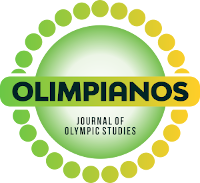Eco-esporte no espaço da cidade moderna
DOI:
https://doi.org/10.30937/2526-6314.v5.id127Palavras-chave:
esporte para todos, esporte urbano, cidade esportiva, cidade sustentávelResumo
O objetivo do artigo é revisar as tendências atuais em soluções espaciais urbanas e programas de ativação de esportes a partir de exemplos em cidades selecionadas. Uma infraestrutura esportiva atrativa que incentiva a recreação ao ar livre e perto do local de residência é um desafio importante para os países reduzirem o sedentarismo, especialmente para os jovens e populações especiais (como indígenas e imigrantes), além de promover a integração social de todas as faixas etárias.
Downloads
Referências
Hall CM. Sport tourism and urban regeneration. In: Ritchie BW, Adair D. (eds). Sport tourism: interrelationships, impacts and issues. Bristol (UK): Channel View Publications; 2004.
Schut P. Outdoor activities and urbanization: a constant bridging throughout the twentieth century in France. The International Journal of The History of Sport. 2017; 34(14):1521-1540. Doi: 10.1080/09523367.2018.1473381.
Rzegocinska-Tyzuk B. Przestrze? sportu w mie?cie-aspekt oszcz?dno?ci. Czasopismo Techniczne. Architektura. 2010;107(6-A/2):109-118.
Ross W, Leopkey R. The adoption and evolution of environmental practices in the Olympic Games. Managing Sport and Leisure. 2017;22(1):1-18.
Cantelon H, Letters M. The making of the International Olympic Committee environmental policy as a third dimension of the Olympic Movement. International Review for the Sociology of Sport. 2000;35(3):294-308.
Trendafilova S, McCullogh B, Phafl M, Nguyen S, Casper J, Picariello M. Environmental sustainability in sport: current state and future trends, Global Journal of Advances in Pure & Applied Sciences. 2014; 3:9-14.
Chappelet J-L. Olympic environmental concerns as a legacy of the Winter Games. The International Journal of the History of Sport, 2008; 25(14):1884-1902.
Omorczyk A. Olympic Games and new sport, recreation and leisure spaces for the local community. Folia Sociologica. 2020;75:121-131.
Smith A. Reimaging the city: the value of sport initiatives. Annals of Tourism Research. 2005; 32(1): 217-236.
Coalter F, Allison M, Taylor J. The role of sport in regenerating deprived urban areas, Edinburgh: HMSO; 2000.
Yuen B. Sport and urban development in Singapore, Cities. 2008;25(1): 29-36.
Friedman M, Andrews DL, Silk ML. Sport and the façade of redevelopment in the postindustrial city. Sociology of Sport Journal. 2004;21(2):119-139.
Rzegocinska-Tyzuk B. Sport w krajobrazie miasta – wybrane zagadnienia roli i kompozycji. Architecture. 2012; 109(1-A/2):145-156.
Kostrzewska M. Sport dla wszystkich w przestrzeni miasta – Raport dla Ministerstwa Sportu i Turystyki [cited 20 jul 2021]. Poland: Ministry of Sport and Tourism of the Republic of Poland; 2016. Available at: https://www.msit.gov.pl/download.php?s=1&id=12249.
Nols Z, Haudenhuyse R, Spaaij R, Theboom, M. Social change through an urban sport for development initiative? Investigating critical pedagogy through the voices of young people, Sport, Education and Society. 2019;24(7):727-741.
Cantin-Brault A. The reification of Skateboarding. International Journal of Sport Culture and Science. 2015;3(1):54-66.
Vermeulen J. The bridge as playground: organizing sport in public space. Culture and Organization. 2011;17(3):231-251.
Malchrowicz-Mosko E, León-Guereño P, Tapia-Serrano MA, Sánchez-Miguel PA, Wa?kiewicz Z. What encourages physically inactive people to start running? An analysis of motivations to participate in Parkrun and City Trail in Poland. Frontiers in Public Health. 2020; 8:1-9.
Downloads
Publicado
Edição
Seção
Licença
Os autores autorizam que outros copiem e redistribuam o material em qualquer suporte ou formato. Remixar, transformar, e criar a partir do material. Não pode usar o material para fins comerciais.






